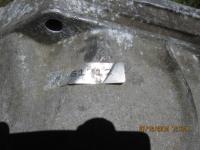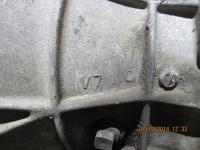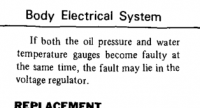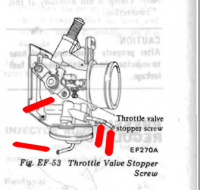Everything posted by Zed Head
-
Advice on putting a Z back together
You can start the engine on a stand, or the ground pretty easily, especially with a carb'ed engine. Hoses to a gas can, the fuel pump which is probably in a box, a battery, and some wires. Might be easier than installing the engine only to find out it needs to be removed. Plus it leaves you room to work until the engine has to go in. You only need to attach the transmission for the starter, no clutch parts are needed. I have my spare engine with a transmission attached sitting on one of those 1000 lb Harbor Freight dollys. I had to reinforce the center boards because the sag screwed up the casters but it's been on there for a year or two. I've had it running with a spare EFI harness and spare radiator.
-
Stock / Street Camshaft and components
You need to get new or reground rocker arms with a new cam. You'll probably need new lash pads also. Delta cams will regrind your rocker arms for about $4 each apparently. They also regrind cams. Many people seem to like the cam from Isky and reground rocker arms from Delta. If you're going to keep your cam until you get another, and you want to go back to the stock grind, then you might consider just buying a used cylinder head and swapping over the cam and its rocker arms and lash pads as a matched set. Each rocker arm needs to stay with its cam lobe. That seems to work. If you get bad rockers (apparently some of the new ones out there aren't very good) or try to re-use used rocker arms, that seems to be a formula for wiping out a cam lobe or more.
-
'90 240SX FS5W71C swap into '75 280z
I have a sticker on mine also. Probably the elusive serial number. It would make more sense to use a sticker, stamp or engraving than to cast it in to the housing. Number applied when the unit is complete and passes inspection.
-
1978 280Z with rare "short-shifter" and AC.
This ad is just fun to read. Has anyone ever heard of the rare 5-speed short-shifter? He's lowered the price because he needs to pay off some artists. It has a racing history. Kids are welcome but it's a two-seater. It's listed in Portland but tagged in CA. He must have run out of camera storage before he could take pictures of anything besides the right rear of the exterior. With the gray primer spots all over. I don't understand... Datsun '78 280z rare options car $$$invested **SALE this week only $8400 steal this at less than half of what I've put into it** Reposting RARE options 1978 280Z L28E with short shift 5spd and factory A/C both work great as does all the NEW parts I have replaced since purchasing this fun, reliable, safe car. Good milage very sporty driving. Over $16.4K invested the first real offer that is not a low ball offer takes it. It does need cosmetic work. $5k+ in new parts alone. I'm taking a MASSIVE loss on this rare classic sports car with racing history (again why systems had to be replaced) ... Found a few cars i want that are more fuel efficient and need money to pay off artists had listed originally @ $9960. Many collectors have tried to pry it from me for 1/3 of what I've put into it and for some reason people want visually appealing and questionable parts. No realistic offer refused and the rare options are 5speed short shifter which is a more comfortable position to shift from and the factory A/C (less than 1500 short shift 5speeds were built or so a long term Z collector had informed me) along with the impossible to find original alloy wheels thanks in advance Matt ... call or email for questions and happy to give a test ride with cash in hand kids welcome NO you can't have it for nothing- NO I will not ship it for you. SALE $9345 more than a $1000 in work since original post-- needs nothing until next oil change @2000miles from now **NO leaks of any fluid VERY reliable solid daily or high collector model with rare options. ***VIN available upon request - huge stack of reciepts and some history of the car available never wrecked CLEAN OR title in hand reg expires 11/14 passed DEQ and CA smog every time
-
'90 240SX FS5W71C swap into '75 280z
Here's my 1985 300ZX (so I was told) bellhousing. Notice the fill plug below. It's the left hand side, and you can see how the case flares (like a bell). Are you sure that all of your pictures are bellhousing and not the back half? Hard to ell since they're all close-up. I have my transmission in the garage but didn't drag it out to see the other side.
-
1970 Z car on Ebay
The mystery bidder could be someone who's seen the car in person and liked what they saw. Surprising that the eBay seller would leave out a detail like shortened struts with adjustable spring perches (aka "coilovers"). That could be worth thousands. Or could subtract thousands for a collector.
-
problems with a few different areas of the car. running poor, no gauges
The 1980 Fuel Injection Guide from xenons130.com will help also. You'll need a multimeter. XenonS130 - S130 Reference Looks like you're working from a tiny phone screen though so life might be difficult. Thanks for the periods, they eased the pain of reading your post.
-
'90 240SX FS5W71C swap into '75 280z
Here's another one - DSC04293JPGThumbnail1jpg id 266482 | Motortopia That bearing is difficult to remove. I had to rig up a cheap two prong gear puller with a clamp to get in to the small space available. Don't forget to put the transmission in to gear when assembling. It's possible to get it stuck in two gears at the same time when the bellhousing/fron case is pushed over the shift rods.
-
Radiator cooling capacity is dropping
Don't forget head gasket and bad gauge as potential causes. Stuck thermostat is a good possibility. If you've been using modern antifreeze formulations with clean water it would be odd for the radiator to get fouled.
-
U-joint for driveshaft
Here's a good link for u-joints, with dimensions. https://www.powertrainindustries.com/catalogs_type.htm?type=UJoints&PHPSESSID=1i4gudsrcok13lt4mf660vloa3 How are you going to retain the new u-joint, since the old one was staked in? If it's not centered perfectly you'll have vibration and without proper retention it could move. Here's a thread, with info on a shop up here in the Portland area. I think that they shorten also. 280z (datsun / nissan) non replaceable ujoint replacement where to go to fix for just $103 in 30 minuets - S30 Series - 240z, 260z, 280z - HybridZ Don't forget that the early 1970 drive shaft is the correct length and will swap right in. Jon Mortensen had one for sale, he might still have it. It's already rebuilt and he wasn't asking much.
-
Front brake problems
One thing that people have done to isolate a problem is to convert one of the fittings in to a plug. For example, take an old fitting with a piece of metal brake line, cut the line short, then bend it and crimp it so it won't leak. Then take that plug and block off various parts of the system. Block the fronts and see if the rears are solid, and vice-versa. Block one caliper, block the other, see if there's a difference. Block the proportioning valves, etc. You can even build two plugs and block the ports from the master cylinder to see if the MC is the problem. Have to say though that you haven't really given a good description of what the pedal is doing. Is it high or low, will it pump up, does it drop if you just hold constant pressure on it... etc. Al I see is soft pedal (what does that mean?), air bubbles in the reservoir, and the rear brakes "work great" (no details on what "great" means). Plus you said the rears work great, but you're reporting bubbles in the rear reservoir. The solution is in the details, but you have to provide those. Good luck.
-
Bayline 8.2.14 By Historic J
I've never heard of Historic J or this event. The picture of a very high stack of containers doesn't tell much at all. Are you a freight handling company?
-
Hot-start issue with EFI - who has it, who doesn't
Welcome to the club and thanks for adding. Fuel quality has been discussed here and there. Unfortunately, most of us have to live with whatever is in the local station's tanks. So far, people with Standard FJ707T injectors, aluminum fuel rails and headers, Standard FJ3 injectors with headers (Post #84), and me with Bosch 0280 150 901 injectors, aluminum fuel rail, and stock manifolds, seem to have eliminated our hot start problems. Although it's not clear if rcb's issue will come back in the winter-time. Here's a really interesting presentation from Lawrence Livermore National Laboratory showing how ethanol affects vapor pressure, but also showing that gasoline can be different in different areas of the country. That's one more thing that gets the discussions messed up, one guy says I have these parts and no problem, another says I have the same parts and have the issue every day. But they're talking about different petroleum distillations, and different ethanol percentages. It's worse now than in the past because modern cars are designed to adjust for the variation. http://www-erd.llnl.gov/ethanol/proceed/autoupd.pdf
-
I'm Bringing Back Tha Twin Stacks ^_^ !
Glad you made it back Wing. The things being reported didn't fit. I figured something out of control was going on. Good luck.
-
Fuel injector replacements
Here's a trick I learned from a machinist I used to work for, a way to keep swarf out of critical areas. Turn the part upside down.
-
GM HEI Module - odds and ends
Assuming the same settings and drill speed, maybe the modified reluctor gives a higher voltage at low RPM. Four divisions for the Z, five and a half for the ZX. Can't tell what the settings are on your scope. Thanks for doing that and posting the results. No clear answer though on why the guy from Hybridz had problems with the HEI module on a ZX distributor. Maybe he had a bad module or had it wired backward. I found a four pin Bosch module that apparently passes 7 amps. But you can get that with an Accel high performance module. Also found that many of the Toyota people are using the GM module when theirs break, 'cause it's cheaper and works just as well.
-
GM HEI Module - odds and ends
Found an alternative to Pertronix for the points guys - Electronic Ignition Module Kit K2543
-
distributor issue
They used dual point or dual electronic pickup distributors in the manual transmission cars also. Nissan wasn't 100% clear about why, some say it was for emissions, but Nissan described sit in Engine Fuel. It actually advances timing about 6 degrees when cold (at least in 1976 it did), which raises idle speed. Good that you're looking at it before you have problems. What you really want to do though is take the distributor out, disassemble it, and make sure the vacuum advance breaker plate mechanism works correctly. Most of them, even in the 80's ZX's, are rusted and bound up. This can cause your timing to get stuck in the wrong place, or react slowly, leaving it advanced when it should be retarded. If you only have the wires for one set of points you can just leave the other set in and run it. If your engine isn't running right, it's probably not because of the extra set of points.
-
freeing corroded tube in tube...ideas sought
Is the outer tube steel? I've had the thought that Naval Jelly (phosphoric acid solution gel) might be worth a try to break a rusted bolt free. When steel or iron rusts, it grows in size. If the Naval Jelly breaks the rust back down maybe it will loosen up. Never tried it but it seems logical. To me.
-
distributor issue
The distributor specs. are in the Factory Service Manual. But there's really no reason the engine shouldn't run smoothly with either. I looked and it seems that the distributors are actually the same but the initial timing setting is different. How do you know that you have an "automatic" distributor? p.s. Texting (with the e.e.cummings writing style) isn't really popular on this forum. Classiczcars.com likes classic writing style.
-
GM HEI Module - odds and ends
Found a 4 pin Honda module with dwell control - Honda OE# 30120-PA6-921, 30120-PB1-006 Ignition Module Compare to another with ECU (ECM) control - Honda OE# 06302-PT2-000, 06302-PT2-A00 Ignition Module One could spend a lot of time exploring 1980's ignition systems. Lot of odd stuff out there.
-
GM HEI Module - odds and ends
Oops. Makes sense, of course. I've even played out in thought the tooth passing the pickup point. Missed that. So the extra metal in front of the tooth on the ZX reluctor. That might get the voltage back above zero sooner maybe? You have your Z trace centered peak to peak and the trace between the peaks looks even top to bottom and side to side. If so, I'd guess the ZX trace might be a little asymmetric. Don't know. You're not going to hook up a coil and measure dwell times and output are you? I'm going to see if I can find out more about the Toyota module. I'm obsessed now.
-
E-88 head swapping
Seems like an N42 or N47 L28 head would be a good choice. It already has the bigger valves and essentially the same combustion chamber size. Isn't it about where you end up after modifying the E88?
-
Too many problems to list...
Here's a picture of where the spring would attach to pull the throttle closed. I bought several at a hardware store and tried a few until one felt right. Also added a line to show where you might have hidden vacuum leaks. each one of those tubes will leak when the throttle is opened but wil be closed when the throttle is closed. They should all have a hose attached (ideal stock configuration) or be sealed (in the meantime).
-
Too many problems to list...
Is this while idling? The small details can have a big impact with these engines. Vacuum leaks are a big problem. You can't really do any tuning at all if youhave vacuum leaks. Also, just the simple basics like getting your ignition timing right, and adjusting valve lash are important. Basic steps before you get carried away. People have spent lots of effort on the wrong things, then found that something basic wasn't set right. There's am Engine Tuneup chapter in the FSM. Do the steps in order and you'll be way ahead.








